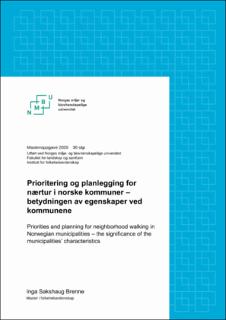| dc.contributor.advisor | Raanaas, Ruth Kjærsti | |
| dc.contributor.advisor | Thorén, Kine Halvorsen | |
| dc.contributor.author | Brenne, Inga Sakshaug | |
| dc.coverage.spatial | Norway | en_US |
| dc.date.accessioned | 2020-10-06T15:52:48Z | |
| dc.date.available | 2020-10-06T15:52:48Z | |
| dc.date.issued | 2020 | |
| dc.identifier.uri | https://hdl.handle.net/11250/2681440 | |
| dc.description.abstract | Bakgrunn: Tilrettelegging for turgåing i nærmiljøet (nærtur) stimulerer til fysisk aktivitet på tvers av sosiale klasser og er et viktig innsatsområde i folkehelsearbeidet. Kommunene har den viktigste rollen i å sikre befolkningen tilgang til attraktive nærturområder, men flere kommuner har mangelfull planleggings- og gjennomføringskompetanse på dette området. Det er store demografiske og økonomiske variasjoner mellom landets kommuner, og vi vet at dette kan påvirke ivaretakelsen av ansvar og oppgaver lagt til kommunesektoren. Vi vet derimot lite om dette påvirker kommunenes arbeid med tilrettelegging for nærtur.
Formål: Formålet med studien er å undersøke om forskjellene mellom hvordan norske kommuner prioriterer og planlegger for tiltak som fremmer befolkningens mulighet for nærtur kan ha sammenheng med strukturelle forskjeller mellom kommunene. Herunder kommunenes størrelse, befolkning, økonomi og tilgang til naturområder.
Metode: Det empiriske grunnlaget tar utgangspunkt i data om kommunenes størrelse, befolkning, økonomi og nærturterreng hentet fra SSB samt data om kommunenes arbeid med nærtur innsamlet av Thorén et al. (2018). Sammenhenger mellom kommunedataene og dataene fra undersøkelsen av Thorén et al. (2018) undersøkes ved statistiske analyser.
Hovedfunn: Det er diskrepans mellom hvordan aktører på politisk og administrativt nivå i kommunene uttaler at nærtur prioriteres og om nærtur faktisk integreres i planarbeidet. Det er hovedsakelig de store kommunene som utpeker seg i nærturarbeidet: størst omfang av kommunene som er mest folkerike, tettest befolket og har størst økonomisk handlingsrom integrerer nærturtiltak i kommuneplanleggingen. Studien synliggjør behov for å styrke plankompetansen i alle landets kommuner, men særlig i de mindre folkerike kommunene. Det er også behov for å formidle betydningen av at kommuner som i dag har tilstrekkelig tilgang til naturområder integrerer nærturtiltak i planarbeidet. Dette for å verne områdene mot fremtidig utbygging, samt tilrettelegge områdene så de inviterer til turgåing. Funnene taler for at de mindre kommunene har mye å lære av de større kommunene når det gjelder prioritering og planlegging for nærtur. | en_US |
| dc.description.abstract | Background: Facilitating walking in the local environment (neighborhood walking) promotes physical activity across social classes and is an important area of focus in public health work. The municipalities possess the important role of ensuring the population access to attractive areas for neighborhood walking. However, several municipalities have inadequate planning and implementation expertise in this area. There are great demographic and economic variations between the country's municipalities, which can affect the fulfillment of responsibilities and tasks within the municipal sector. However, how this relates to the municipalities’ facilitation for neighborhood walking is not known.
Purpose: The purpose of this study is to investigate whether the difference between how Norwegian municipalities prioritize and plans for measures that promote the population’s opportunity to walking in their neighborhood may be related to structural differences between the municipalities. These differences include size, population, economy and access to nature areas.
Method: The empirical basis consists of data on the municipalities’ size, population, economy and access to nature areas obtained from Statistics Norway, and data on the municipalities' facilitating for neighborhood walking collected by Thorén et al. (2018). Statistical analyzes is conducted to examine relationships between these datasets.
Main findings: There is a disparity between how actors at the political and administrative level in the municipalities states that neighborhood walking is prioritized, and whether neighborhood walking is actually integrated in the municipal planning. Mainly, the largest municipalities stand out: The municipalities with the highest population, highest population density and the largest economy integrates neighborhood walking into their planning, to the greatest extent. The study highlights the need to strengthen planning skills in all municipalities, but especially in those who are less populous. Also, it’s necessary to convey the importance of integrating neighborhood walking into the municipal planning in the municipalities that already have sufficient access to nature areas. This is to protect and preserve these nature areas, as well as to facilitate that they appear attractive for walking. The findings indicate that the smaller municipalities should learn from the largest municipalities when it comes to prioritizing and planning for neighborhood walking. | en_US |
| dc.language.iso | nob | en_US |
| dc.publisher | Norwegian University of Life Sciences, Ås | en_US |
| dc.rights | Attribution-NonCommercial-NoDerivatives 4.0 Internasjonal | * |
| dc.rights.uri | http://creativecommons.org/licenses/by-nc-nd/4.0/deed.no | * |
| dc.subject | Folkehelse | en_US |
| dc.subject | Kommuneplanlegging | en_US |
| dc.subject | Friluftsliv | en_US |
| dc.title | Prioritering og planlegging for nærtur i norske kommuner : betydningen av egenskaper ved kommunene | en_US |
| dc.title.alternative | Priorities and planning for neighborhood walking in Norwegian municipalities : the significance of the municipalities’ characteristics | en_US |
| dc.type | Master thesis | en_US |
| dc.description.localcode | M-FOL | en_US |

